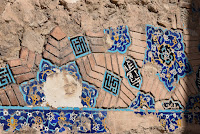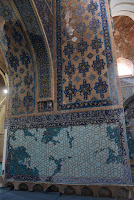Sunday morning was dedicated to exploring the city of Tabriz, which we had reached the previous night. From inside the bus as we passed by the Municipality Palace area the city looked much more modern than I had imagined it to be.


Our first stop was at the remnants of a big unfinished Mausoleum, whose original construction is said to have taken place between 1318 and 1339, during the Ilkhanate period. During the Russian invasion the Argwas used as a central military command.. Close to it stood a new mosque, which in my humble opinion highlighted the architectural features of the Arg.

From there we walked towards the Blue Mosque complex, which said to have been built in the Kara Koyunlu dinasty, more precisely in 1465, was severely damaged in an earthquake that occured in 1780.





I must confess I wasn't immediately impressed, though the moment I was called the attention to certain architectural details I was mentally forced to change my initial opinion.
The various Kufic and Thuluth scripts on the facades, as well as the arabesque patterns and the chromatic compositions were created by a famous calligrapher. Remains of the original building show the mosque was mostly covered with turquoise and hexagonal tiles with the ceiling having been gold inlaid and the sanctuary floors made of marble, thus bearing witness of its earlier grandeur.
Many decorative elements of the Mosque revealed a high level of craftsmanship and that's precisely what had me strolling around photographing details as I let myself be "taken" by them, particularly in regards to its interior.


















Joëlle and Dominique with an Iranian family who asked to have theor picture taken with them.














































No comments:
Post a Comment